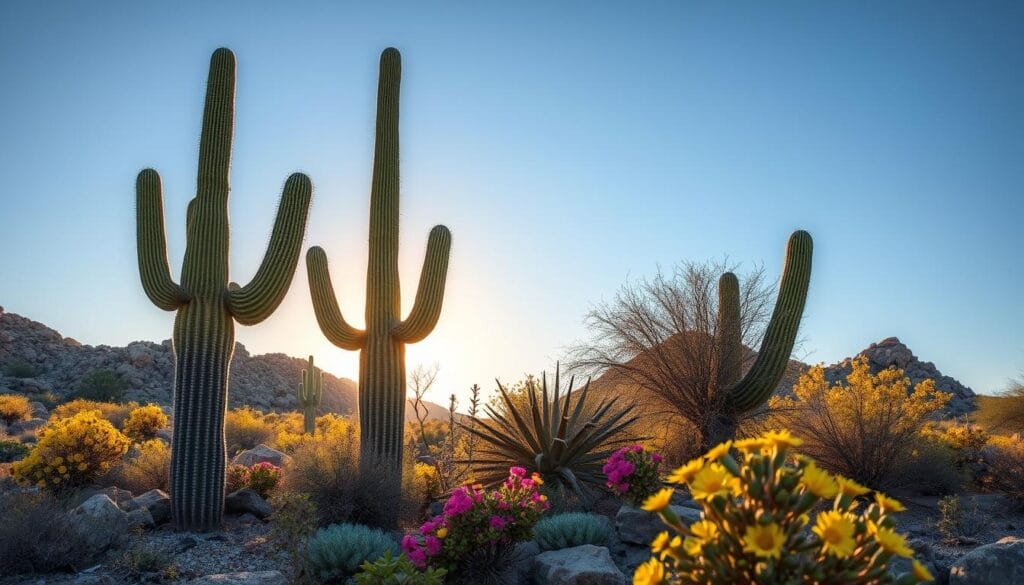Did you know the saguaro cactus can grow up to 60 feet tall and live for 200 years1? This desert giant, known as Carnegiea gigantea, is more than a plant. It’s a symbol of the American Southwest. Its ability to adapt and thrive in the Sonoran Desert is truly remarkable.
The saguaro starts its life in the harsh landscapes of southern Arizona, the Whipple Mountains, and parts of California and Mexico. These cacti have found a way to survive in one of the toughest environments on Earth. They are a symbol of resilience and beauty.
Saguaro National Park, created in 1933 and expanded in 1995, shows the importance of protecting these plants and their home2. It covers about 150 square miles near Tucson. The park is home to thousands of saguaros, each with its own story of survival and adaptation3.
What amazes me about the saguaro is how it grows slowly but steadily. These cacti don’t rush; they take their time. They develop their distinctive upturned arms only after 75-100 years of life. This reminds us that in nature, patience is often rewarded with the most impressive sights.
Key Takeaways
- Saguaro cacti can live up to 200 years
- They are native to the Sonoran Desert region
- Saguaro National Park protects thousands of these cacti
- They grow slowly, developing arms after 75-100 years
- Saguaros are crucial for the desert ecosystem
- They can reach heights of up to 60 feet
- The cactus is highly adapted to its arid environment
Introduction to the Saguaro Cactus
The saguaro cactus is a symbol of the American Southwest. It’s known for its tall size and unique look. These cacti can grow up to 50 feet tall4.
The Icon of the American Southwest
The saguaro’s shape is easy to spot. It has a tall trunk and arms that point up. It takes 75 to 100 years for them to grow arms, up to 244. Without arms, it’s called a “spear.”5

Native Range and Habitat
Saguaros live only in the Sonoran Desert. They are found in southern Arizona, parts of California, and western Sonora, Mexico4. They need a specific climate and can’t handle cold. Their roots can go up to 100 feet deep to find water4.
Significance in Sonoran Desert Ecosystem
The saguaro is key to the Sonoran Desert. It gives food and shelter to many animals4. It’s also the Arizona state flower, blooming from April to June5.
| Characteristic | Details |
|---|---|
| Height | 10-40 feet (up to 50 feet) |
| Lifespan | 150-175 years (some over 200) |
| Root System | Extends up to 100 feet |
| Arm Development | At 75-100 years old |
| Flowering Period | April – June |
The saguaro is amazing for its ability to survive in the desert. It’s important to protect these cacti for the future.
Saguaro Cactus (Carnegiea gigantea): Physical Characteristics
The saguaro cactus is a giant in the Sonoran Desert. It has amazing traits that show how it adapts to the desert. These plants are truly incredible.
Height and Growth Patterns
Saguaros grow very slowly. They can grow up to 50 feet tall and weigh nine tons when fully grown6. It’s amazing that a one-inch tall saguaro is only six years old7.
It takes 70 years for a saguaro to grow 6.5 feet and start flowering7.

Distinctive Arms and Their Development
The saguaro’s arms are truly unique. They start growing their first arm around 95-100 years old, when they’re 15-16 feet tall7. Some saguaros have dozens of arms, making a striking view against the sky7.
These arms help the cactus make more flowers and fruits. They increase the surface area for reproduction.
Root System and Water Storage
Saguaros have a wide and shallow root system. This helps them catch rainfall efficiently. When full of water, a saguaro can weigh over a ton, storing lots of water in its tissue7.
This amazing ability lets the cactus survive in the desert. It shows how desert plants have adapted to their environment.
The saguaro’s traits show its incredible desert adaptation. Its height and water storage are key to its survival. Its slow growth teaches us about patience and resilience in harsh places.
Life Cycle and Longevity
I’m always amazed by the saguaro lifespan. These desert giants can live over 150 years, with some reaching the ripe old age of 2008. The saguaro’s journey starts small, with seedlings facing tough odds in the harsh desert environment.
The cactus growth rate is slow but steady. In its early years, a saguaro typically grows just 1 to 2 inches annually8. By age 50, it might stand 10-15 feet tall8. This gradual growth is a key part of the desert plant lifecycle, allowing the saguaro to adapt to its challenging surroundings.
Saguaros start their reproductive phase around 30 years old, but they hit their stride between 50 and 708. During this time, they flower profusely from late April to June8. A mature saguaro can produce thousands of seeds annually8.
The saguaro’s lifecycle is marked by distinct stages. It takes 50 to 70 years for a saguaro to reach full height and reproductive capability8. This long maturation process highlights the importance of conservation efforts to protect these slow-growing desert icons.
| Age (years) | Milestone | Height (feet) |
|---|---|---|
| 30 | Begin flowering | 6-8 |
| 50-70 | Peak reproduction | 15-20 |
| 150-200 | Maximum lifespan | 40-60 |
Long-term studies have provided valuable insights into saguaro populations. In Saguaro National Park, researchers found that 828 saguaros were established between 1959 and 1993, compared to only 34 in the previous 16 years9. This data underscores the importance of ongoing monitoring to understand the impacts of climate change and human activity on these majestic cacti.
Adaptations for Desert Survival
I’m always amazed by how the saguaro cactus thrives in harsh desert conditions. These giants have developed incredible desert adaptations over time. Let’s explore how they master water conservation and survive in their arid habitat.
Water Conservation Mechanisms
Saguaros are masters of water conservation. Their shallow, extensive root systems can absorb rainfall quickly from the surface10. During rainy periods, the stems and arms expand along accordion-like pleats to store water10. In dry times, they slowly use this stored water, causing the cactus to shrink10. A saguaro’s roots can stretch up to 100 feet, allowing it to soak up and store rainwater efficiently11.
Protective Spines and Waxy Coating
The saguaro’s outer skin has a waxy coating that prevents water loss through evaporation10. Rows of sharp spines cover the cactus, protecting it from predators and extreme temperatures10. These adaptations are crucial for surviving in the hot, dry desert.
Photosynthesis and CAM Metabolism
Saguaros use a special form of photosynthesis called Crassulacean Acid Metabolism (CAM). This process allows them to open their stomata at night, reducing water loss. They’ve also eliminated leaves to conserve water, relying on their stems for photosynthesis10.
| Adaptation | Function |
|---|---|
| Extensive root system | Absorbs surface rainfall quickly |
| Expandable stems | Stores water during rainy periods |
| Waxy coating | Prevents water loss through evaporation |
| Protective spines | Deters predators and regulates temperature |
| CAM photosynthesis | Reduces water loss during gas exchange |
These remarkable adaptations allow saguaros to thrive in the Sonoran Desert. They play a crucial role as keystone species, supporting various wildlife with food and shelter11. Sadly, climate change and urban expansion threaten their habitat. Hotter summers in the Phoenix Valley impact their natural cooling period, while invasive species compete for scarce water resources12.
Reproductive Process and Pollination
I’m always amazed by the saguaro’s reproductive process. These desert giants don’t rush into things. It takes about 35 years for a saguaro cactus to reach maturity and produce its first flowers13. The saguaro flowers are a sight to behold, large and white, opening at night like nature’s own nightclubs.
Bat pollination plays a crucial role in the saguaro’s life cycle. As the sun sets, these nocturnal visitors swoop in, attracted by the sweet nectar. Bees and birds join the party come morning, ensuring thorough pollination. This teamwork results in bright red fruits, each packed with thousands of tiny seeds.
Seed dispersal is a numbers game for saguaros. A single cactus may produce upwards of 100 fruits each year13. Over its lifespan, which can stretch beyond 200 years, a saguaro might produce millions of seeds13. But nature is selective. Only a handful of these seeds will beat the odds, germinating and growing to maturity13.
| Saguaro Reproduction Facts | Data |
|---|---|
| Age at first flowering | 35 years |
| Fruits produced annually | Up to 100 |
| Seeds produced in a lifetime | Millions |
| Successful germination rate | Very low |
In Saguaro National Park, home to over 2 million saguaros, this reproductive dance plays out on a grand scale14. The park’s diverse elevation range, from sea level to 4,500 feet, provides varied habitats for these cacti to thrive and reproduce14. It’s a testament to nature’s resilience and the saguaro’s remarkable adaptability.
Ecological Importance
The saguaro cactus is key to desert ecology. Its role in the Sonoran Desert is truly remarkable.
Keystone Species in the Sonoran Desert
Saguaros are the backbone of their ecosystem. The Sonoran Desert is home to over 550 animals and 2,000 plants, making it the most diverse desert in North America15. These cacti offer food and shelter, making the desert a vibrant ecosystem.
Interactions with Wildlife
Wildlife and saguaros have a special bond. Birds like Gila woodpeckers make homes in the cacti. These homes help other animals, creating a cycle of life in the desert. The park is home to over 50 mammals, including javelinas and bobcats, all relying on saguaros15.
Role in Native American Culture
The saguaro holds deep meaning for Native Americans. For the Tohono O’odham, these cacti are sacred, representing their ancestors. They use every part of the saguaro, showing its importance in their culture.
“The saguaro is not just a plant to us. It’s our relative, our teacher, our provider.”
Climate change threatens these desert giants. Studies show that climate changes could alter where saguaros grow16. Efforts are underway to protect these cacti, especially rare ones like the crested saguaro, from harm17.
| Ecosystem Role | Cultural Significance | Conservation Status |
|---|---|---|
| Keystone species | Sacred to Tohono O’odham | Threatened by climate change |
| Provides shelter for wildlife | Used for food and materials | Protected in national parks |
| Supports biodiversity | Symbolizes ancestral spirits | Subject of ongoing research |
Conservation Status and Threats
The saguaro cactus is a key symbol of the American Southwest. These plants can grow up to 40 feet tall and live over 150 years. This makes saving them very important18. Efforts to protect saguaros are underway, but climate change and invasive species are big threats.
Current Conservation Efforts
The Tucson Audubon Society is planting 14,000 saguaro cacti over two years. They want to help saguaros that are in danger19. They’ve got $500,000 in grants to help with this big project19.
This project is focused on areas that have recovered from wildfires. It shows how urgent it is to save saguaros.
Challenges from Climate Change and Invasive Species
Climate change is worrying for the saguaro’s future in its home18. The Southwestern drought has made it hard for new saguaros to grow19. Invasive species like buffelgrass are also a problem. They take water and increase fire risks, which harms saguaros19.
Legal Protections and Future Outlook
Saguaros have legal protection, but growing them back is slow. It takes about 35 years for a saguaro to start flowering. It takes over a century to reach adulthood19. After a big fire, it could take up to 150 years for new saguaros to grow back and support other animals19.
This shows how important it is to keep working on saving saguaros. We need to protect these special desert plants. Learn more about desert plants and why they matter.
The future of the Sonoran Desert is uncertain. Without cacti, animals would lose food and homes18. We must act to stop saguaros from disappearing from the desert19. We need to keep studying, saving, and spreading the word about these desert giants for the next generations.
Saguaro National Park: Protecting the Desert Giant
I’ve visited Saguaro National Park, a true gem for desert conservation and Arizona tourism. This national park, spanning 91,716 acres, showcases the majestic saguaro cactus in its natural habitat20. The park’s two districts offer unique experiences for nature lovers.
In 2022, Saguaro National Park welcomed over 908,000 visitors, highlighting its popularity as a tourist destination20. The park’s diverse landscape includes towering saguaros that can reach heights of 50 feet and ages exceeding 200 years21. These desert giants are a sight to behold, with some weighing up to seven tons22.
The park offers extensive hiking opportunities with over 170 miles of trails across both districts21. I particularly enjoy the Cactus Forest Loop, an 8-mile trail that winds through the Rincon Mountains21. For those preferring a shorter walk, the Valley View Overlook Trail in the Tucson Mountains provides a scenic 1-mile hike21.
Conservation efforts in the park are crucial. In 2010, an estimated 1.9 million saguaros were within the park boundaries22. To combat poaching, some saguaros are fitted with microchip identification tags22. The park also faces challenges from climate change and invasive species like buffelgrass, which threaten the natural fire regimes of the Sonoran Desert22.
| District | Elevation Range (feet) | Average Annual Precipitation (inches) |
|---|---|---|
| Rincon Mountain | 2,670 – 8,666 | 14.04 |
| Tucson Mountain | Lower | Less |
Saguaro National Park plays a vital role in preserving the unique Sonoran Desert ecosystem. Its efforts in desert conservation and promotion of sustainable Arizona tourism make it an essential destination for nature enthusiasts and researchers alike.
Conclusion
I’ve grown to admire the saguaro cactus as a symbol of desert conservation and Arizona’s rich heritage. These towering plants can grow up to 60 feet tall and weigh as much as 4,800 pounds when full of water23. They can live for up to 200 years, but face dangers from poachers who value them highly2324.
The saguaro’s role goes beyond its size. It supports many other creatures in the Sonoran Desert23. Recent studies have uncovered the cactus’s genetic variety, using massive amounts of data from 20 plants across 10 locations25. These studies found the highest genetic diversity near the Gulf of California in Mexico, suggesting where the saguaro came from25.
Thinking about the saguaro’s importance, I’m reminded of its cultural value to the Tohono O’odham Nation. They use its fruit for food and drinks23. The cactus’s flower is even Arizona’s state flower, highlighting its significance in the state’s identity23. Protecting these desert icons is vital for preserving the Southwest’s biodiversity and cultural heritage, especially with threats from climate change and human activities.
FAQ
What is the saguaro cactus?
How long can saguaros live?
What adaptations help saguaros survive in the desert?
How does the saguaro cactus reproduce?
What is the ecological importance of saguaros?
What is the cultural significance of saguaros?
What threats do saguaros face?
How are saguaros protected?
Source Links
- Saguaro Cactus – Carnegiea gigantea
- The iconic giant saguaro cactus in the Sonoran Desert
- Narratives Details – The William & Lynda Steere Herbarium
- Sonoran Desert Fact Sheet – Saguaro Cactus
- Saguaro
- Lady Bird Johnson Wildflower Center
- Saguaro Cactus – Organ Pipe Cactus National Monument (U.S. National Park Service)
- 🌵 Key Milestones in Saguaro Cactus Growth
- Saguaro (Carnegiea gigantea) Mortality and Population Regeneration in the Cactus Forest of Saguaro National Park: Seventy-Five Years and Counting
- Untitled-7
- Sonoran Desert Fact Sheet – Saguaro Cactus
- Sweltering Saguaros: Heat, Heart, & Saguaros – Planet Forward
- The Saguaro Cactus Life Cycle: step-by-step guide with pictures
- Saguaro – Saguaro National Park (U.S. National Park Service)
- Ecology of Saguaro National Park
- Potential changes in the distribution of Carnegiea gigantea under future scenarios
- Crested Saguaro Cactus a Wonder of the Sonoran Desert
- Saving the Beloved Saguaro Cactus – Green Living Magazine
- Climate Change Wiped Out Thousands of the West’s Most Iconic Cactus. Can Planting More Help a Species that Takes a Century to Mature? – Inside Climate News
- Saguaro National Park
- Saguaro National Park | Visit Arizona
- Saguaros at the Park
- Saguaro Cactus: From Life to Death | AMNH
- Origin and Diversification of the Saguaro Cactus (Carnegiea gigantea): A Within-Species Phylogenomic Analysis


